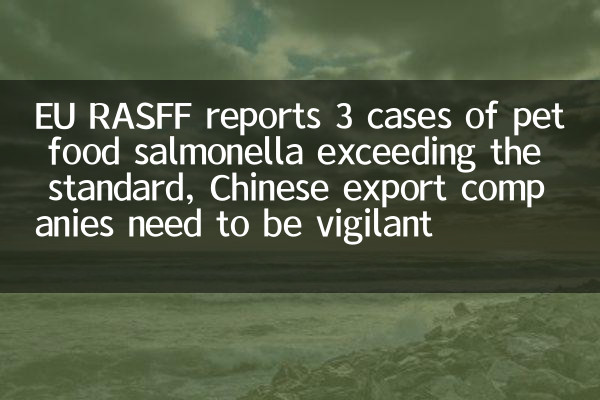EU RASFF reports 3 cases of pet food salmonella exceeding the standard, Chinese export companies need to be vigilant
Recently, the EU Rapid Food and Feed Early Warning System (RASFF) released data for the past 10 days, including 3 cases of salmonella exceeding the standard in pet food, which attracted industry attention. These cases of notification are related to Chinese export companies, reminding relevant companies to strengthen quality control to avoid trade losses due to hygiene problems.
Salmonella is a common foodborne pathogen that can cause gastrointestinal diseases in animals and humans. If pet food is contaminated, it will not only endanger the health of the pet, but may also be transmitted to humans through contact. The EU has extremely strict hygiene standards for pet food, and this notice once again highlights the regulatory pressure faced by Chinese export companies.

RASFF notification data summary (next 10 days)
| Notification date | Product Type | Country of origin | Notify the country | Risk Type | Handling measures |
|---|---|---|---|---|---|
| 2023-11-05 | Dog food (freeze-dried) | China | Germany | Salmonella exceeds the standard | Market recall |
| 2023-11-08 | Cat food (granules) | China | France | Salmonella exceeds the standard | Refused to enter at the port |
| 2023-11-12 | Pet snacks (chicken strips) | China | Netherlands | Salmonella exceeds the standard | destroy |
Problem analysis and response suggestions
It can be seen from the notification data that salmonella contamination problems are concentrated in freeze-dried, granules and snack pet foods. If the raw materials of these products (such as meat and poultry) are processed or stored improperly, it is very easy to breed bacteria. Here are the possible reasons and suggestions:
1.Raw material pollution: Some companies may not conduct strict testing of raw materials. It is recommended to strengthen supplier review and increase microbial testing when raw materials enter the factory.
2.The hygiene in the production process does not meet the standards: Incomplete disinfection of processing equipment or irregular personnel operations may lead to secondary pollution. Enterprises need to improve the HACCP system and regularly train employees.
3.Insufficient transportation and storage conditions: High temperature and high humidity environments will accelerate bacterial reproduction. Exported products should ensure cold chain transportation and clearly marked storage conditions.
Industry impact and future trends
This notice may have a short-term negative impact on domestic pet food exports. The EU is an important market for pet food in China, with exports exceeding 500 million euros in 2022. If similar incidents occur frequently, stricter access restrictions may arise.
It is worth noting that the global pet food safety supervision has shown the following trends recently:
| Country/Region | New regulations | Effective time |
|---|---|---|
| EU | Revise pet food microbial limit standards | Q1 2024 |
| USA | Salmonella test report is required | December 2023 |
| Southeast Asia | Pilot electronic certification for pet food import | Pilot in 2024 |
Corporate Action Guide
In order to cope with increasingly strict international regulation, Chinese export companies can take the following measures:
1.Establish a fast response mechanism: Regularly monitor international notification systems such as RASFF and FDA to warn of risks in advance.
2.Upgrade detection capabilities: Equipped with PCR detectors and other equipment, and include salmonella detection in each batch of required inspection items.
3.Apply for international certification: Passed EU FAMI-QS, US FDA registration and other certifications to enhance product credibility.
4.Strengthen supply chain traceability: Use blockchain technology to record raw material sources, production batches and logistics information.
At present, competition for pet food exports is becoming increasingly fierce. Only by putting food safety first can we win long-term development space in the international market. Relevant enterprises should take this as an opportunity to comprehensively improve their quality management level.